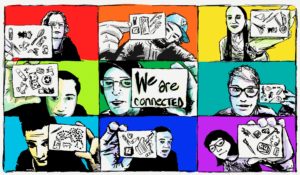Education During a Pandemic – Envision the Positive
Finding the Silver Linings in Education During a Pandemic
By Beth Buoro
By its very nature, education is always on a forward trajectory; students, families, teachers, and administrators are on a lifelong path of growth and learning together. Education during a pandemic is strikingly different. Yet education must go on. In the face of challenge, we still need to envision the positive. How do we move forward and navigate this new educational landscape together? What do we wish for the future of education? How do we create stronger learning communities now and in the future? Those are some of the challenging questions I posed to a teacher of teachers, Dr. Jayme Hines, Keene State College (KSC) Early Childhood Professor, and the glass started to look a lot more full than empty.
Change is Always Part of the Educational Landscape
My career has afforded me the opportunity to serve in a wide variety of positions in the field of education. From my role as a superintendent to treasured time as a classroom teacher, change has been constant . During my tenure, I’ve experienced multiple new initiatives: standards-based instruction, teacher accountability, statewide standardized assessment, mainstreaming, inclusion, UDL, performance-based assessment, and competency-based instruction, just to name a few. But none of these initiatives have turned education upside-down quite like the pandemic, which has rapidly changed the structure and design of 21st century schools as we know them. How do we adapt to change with such short notice?
Consequences of Fast Tracking Remote Learning
Recently, I had the opportunity to talk with Dr. Hines about the impact of the move to remote learning this past spring. Specifically, we discussed the effect of remote learning on students, teachers, parents and KSC student teachers participating in field experiences. Jayme provided a unique perspective as a faculty member working with preservice teachers, as well as the parent of a high school student.
The negative impacts on students are obvious…
- Limited connections with teachers and friends.
- Disruption to instruction, and the lack of an established, consistent routine.
- Teachers have difficulty connecting with and teaching all students, particularly when some families lack the necessary technology for remote learning.
- Less opportunity for social and academic interaction, even with hybrid learning and the various scenarios for in-person classes this fall.
- The social cost of physical distancing and the reduced number of days in the physical school.
Finding the Silver Lining in Educational Disruption
Despite these negatives, Dr. Hines and I were able to identify several positive impacts remote learning has had on education – the silver linings, so to speak.
- Preservice teachers reported more consistent connections with families. They have been able to step up their engagement with families in ways that wouldn’t have been possible if they were completing their field experiences in the classroom.
- Gains in teacher proficiency in technology/videography have been made by virtue of being required to plan and implement remote instruction. These teacher candidates will enter the workplace with unique teaching skill sets that haven’t been seen before and will serve them well in their careers.
- Students (and their parents/guardians) have developed technology skills beyond what would have been learned in the classroom environment.
- Some students have a higher level of comfort with remote instruction as it better aligns with their learning style.
- Teachers have increased their ability to differentiate instruction by virtue of individual and small group instructional practices.
- Parents have been given the first hand opportunity to better understand and appreciate how hard teachers work to plan and implement instruction, and engage students in their learning.
Reach for the Positive in Education
So what will the future of education look like? The wisdom of John Dewey, 20th century education reformer and philosopher, reminds us that teaching and educating people, no matter your age, is fluid and subject to change every day. “If we teach today’s students as we taught yesterday’s, we rob them of tomorrow.” Change is upon us, but with change comes a deeper understanding of the vital importance of finding new and innovative ways to engage students in their learning within safe and supportive classroom environments. When I asked Dr. Hines what she wishes for the future of education, she replied that she hopes empathy and compassion will rise above all things this school year. That we need to continue doing what’s best for all children, and figuring out ways to create community and stay connected. I couldn’t agree more!
Visit Keene State College online to get more information about Dr. Jayme Hines and her work and check out the article When Student Teaching Moves Online.
